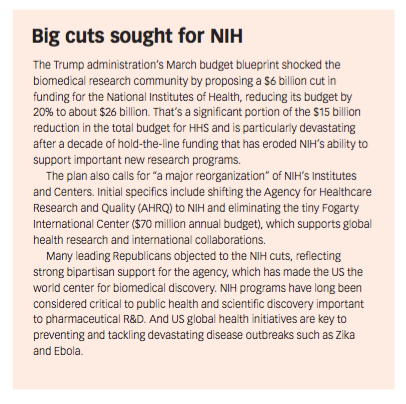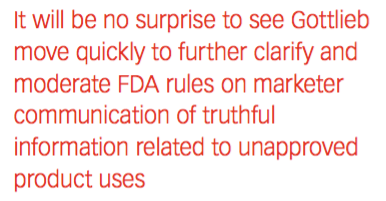A Faster, More Flexible, and Frugal FDA?
Pharmaceutical Executive
Jill Wechsler outlines how the new FDA commissioner tasked with curbing regulation, speeding approvals-and collecting more fees to do it.
A top priority for FDA this year has been to gain speedy Congressional approval of new user fee reauthorization bills. Now, White House proposals to slash funding for federal health agencies and to boost FDA reliance on medical product fees makes that task more critical, and more difficult. The administration’s budget “blueprint” calls for boosting
Jill Wechsler

industry fees by $1 billion in 2018 in order to reduce appropriated funds for pre-market review: “In a constrained budget environment, industries that benefit from FDA’s approval can and should pay for their share,” states the “America First” budget plan.
It’s not clear, though, just how the administration would double FDA user fees. The agency already is scheduled to collect $2 billion in a variety of fees this year, as it did in 2016, about $860 million of that authorized by the Prescription Drug User Fee Act (PDUFA). Yet, these fees are intended to supplement, and not replace, appropriated funds. And doubling current drug fees would involve renegotiating the PDUFA VI package in just a few weeks, a perilous undertaking at this stage in the process.
An added complication in moving forward on user fee reauthorization is the expected host of “add-on” proposals to any user fee package. There’s growing enthusiasm on Capitol Hill for measures that facilitate patient access to experimental therapies under compassionate use programs. Drug pricing also is a hot issue, and FDA legislation may include proposals in this area, despite agency efforts to keep out of the pricing fray. Both Democrats and some Republicans support measures that permit Americans to purchase drugs at lower prices from Canada, and possibly other countries. The administration and most Democrats still want to authorize Medicare to negotiate prices of covered drugs.
More agreeable to industry are proposals to revise how Medicare Part B reimburses for medicines administered in doctors’ offices and to change Medicaid policies that discourage pharma development of value-based reimbursement models. Transparency in drug pricing practices is another popular theme, with legislation proposed to open up the rebate and discounting process.
Transparency is an important issue for Scott Gottlieb, who is slated to head FDA. He has expressed interest in legislation that authorizes FDA release of complete response letters, and user fee legislation could seek to clarify FDA authority to disclose that and other confidential information. Gottlieb also backs strategies to facilitate FDA approval of generic drugs to inject more competition in prescription drug markets. He has urged changes in FDA rules to facilitate testing
Sidebar: Potential Cuts at NIH (click to enlarge)

and approval of complex generics, and there’s support in Congress for ensuring generic drug maker access to brand comparators.
User fees are just one item on the FDA commissioner’s ever-expanding “to-do” list. There are tight deadlines for implementing the 21st Century Cures legislation, including measures designed to streamline clinical testing and to spur development of new medical products. Other hot-button, non-drug issues also will demand attention, including FDA regulation of clinical laboratory tests, cellular and gene therapies, food from gene-edited animals, genetic testing clinics, digital health applications, and blood supply safety, to name a few.
More communications
It will be no surprise to see Gottlieb move quickly to further clarify and moderate FDA rules on marketer communication of truthful information related to unapproved product uses. Earlier this year, FDA issued two important draft guidances in this area, one providing more leeway for sponsors to present healthcare economic information (HCEI) to payers, formulary committees, and other knowledgeable parties. The other document clarifies how companies may present data and information not in a product’s approved label, but “consistent with the FDA-required labeling”-or CFL, a new abbreviation. These proposals have generated so much discussion that FDA extended the formal comment period to April 19. They will be considered along with an agency memorandum on how FDA regulation of commercial speech impacts public health and safety and innovation.
The HCEI guidance goes further than marketers expected by permitting the presentation of information to payers on investigational drugs and medical devices. Formulary committees and insurers have pressed for such advance communications to help them anticipate when an important new product is coming to market and would see coverage and formulary placement. Here, marketers need to clearly state that the product is under investigation; any hint that a product is FDA-approved is “not appropriate,” stated Elaine Hu Cunningham, senior advisor in FDA’s Office of Prescription Drug Promotion (OPDP), at the DIA advertising and promotion regulatory affairs conference in February.
In its CFL document, FDA clarifies that added information has to be truthful and non-misleading and meet a three-factor analysis described by the agency. The aim is for FDA to help sponsors provide prescribers and health professionals (not consumers) with new information outside the product label that could enhance

patient care. CFL information has to involve similar conditions of use and relate to the same indications and patient population in the approved labeling. New information that is not CFL includes product use at different disease stages, in different strengths or dosage forms, through different routes of administration, or to treat different medical conditions. But falling in the gray area of information that could be CFL is new data on long-term safety, additional adverse events, certain added patient subgroups, patient-reported outcomes on approved uses, more convenient dosing schedules, and comparisons to other products.
While marketers applauded the new guidances, they convinced FDA to go back to the drawing board with a new final rule on how to interpret “intended use” of a regulated product. FDA said it never intended to change its policy, but has put off further consideration of the issue until March 2018.
These documents provide a clear starting point for Gottlieb to orchestrate a fresh approach to FDA regulation of commercial speech that addresses long-held industry concerns about agency curbs on a range of communications and marketing practices that raise free speech issues. FDA, as with other federal agencies, has been instructed to eliminate outmoded and overbearing regulations, along with redundant or unjustified functions.
Jill Wechsler is Pharmaceutical Executive’s Washington Correspondent. She can be reached at jllwechsler7@gmail.com

Addressing Disparities in Psoriasis Trials: Takeda's Strategies for Inclusivity in Clinical Research
April 14th 2025LaShell Robinson, Head of Global Feasibility and Trial Equity at Takeda, speaks about the company's strategies to engage patients in underrepresented populations in its phase III psoriasis trials.
Beyond the Prescription: Pharma's Role in Digital Health Conversations
April 1st 2025Join us for an insightful conversation with Jennifer Harakal, Head of Regulatory Affairs at Canopy Life Sciences, as we unpack the evolving intersection of social media and healthcare decisions. Discover how pharmaceutical companies can navigate regulatory challenges while meaningfully engaging with consumers in digital spaces. Jennifer shares expert strategies for responsible marketing, working with influencers, and creating educational content that bridges the gap between patients and healthcare providers. A must-listen for pharma marketers looking to build trust and compliance in today's social media landscape.